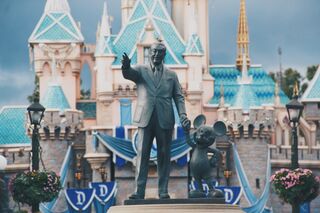Cross-Cultural Psychology
Understanding the Decline in Shared Consumer Experiences
What is the role of mass market brands in the American social fabric?
Posted October 19, 2021 Reviewed by Abigail Fagan
Key points
- In mid-century American culture, brands often represented camaraderie and shared purpose.
- The American middle class has declined steadily in the decades since, impacting the ways in which companies appeal to consumers.
- As the economic divide has widened, fewer and fewer brands have appealed to consumers across socioeconomic lines.
This is part 1 of a multi-part series focusing on the role of brands in the social fabric.
Should brand logos be considered art? If you asked Vladimir Nabokov, the answer would be a resounding "no." The mid-century Russian author was an admirer of American painter Norman Rockwell who, among other things, stenciled logos and advertisements of some of the most iconic brands.
Nabokov remarked that while Rockwell had brilliant technique, it was put to "banal" use depicting everyday life and consumer items. Rockwell's famous portraits of middle-class children happily eating Kellogg's cereal in the pajamas just didn't do it for him. He went so far as to say that "Salvador Dalí is really Norman Rockwell's twin brother kidnapped by Gypsies in babyhood." How's that for a backhanded compliment?

Nabokov may have been slightly warmer to one of Rockwell's successors, Andy Warhol. Warhol was a fan of Rockwell's, owned paintings of his, and was influenced by his artistic focus on American Culture. If Norman Rockwell distilled Americana in the 1940s, Warhol captured this through his own unique lens of "pop art" in the 60s and 70s.
According to Jesse M. Kowalski, formerly of The Andy Warhol Museum, “Both men had their finger on the pulse of America. They knew what America wanted, yet crafted their own vision of America, offering a mirror on American culture."
For Warhol in particular, brand logos and packaging featured even more prominently. From his famous Campbell's soup cans to Chanel perfume bottles, Warhol saw the deep connection between these ubiquitous brands and everyday, middle-class culture.
Logos and Popular American Culture
This kind of brand-based cohesion is typified by one of America's most iconic brands, Coca-Cola. Over a half-century of consistent marketing has made Coke synonymous with happiness. By definition, mass-market brands require personalities and attributes that have mass appeal, and what could possibly be more appealing than the feeling of goodness itself? The ubiquity of Coca-Cola in American life gave it an 'every person' appeal like no other. Like Rockwell before him, who painted several of Coke's advertisements, Warhol saw Coke as embodying the American middle class, and a testament to The American Dream.
And to Warhol, Coke stood above the rest. He remarked, "You can be watching TV and see Coca-Cola, and you know that the President drinks Coke, Liz Taylor drinks Coke, and just think, you can drink Coke, too. A Coke is a Coke and no amount of money can get you a better Coke than the one the bum on the corner is drinking. All the Cokes are the same and all the Cokes are good. Liz Taylor knows it, the President knows it, the bum knows it, and you know it."

It's difficult to imagine the same sentiment uttered today. For one, Warhol's observation that "We all drink Coke, and all Coke is equally good" is now literally untrue. Soda sales have gone down precipitously, and the market share of fizzy drinks has been overtaken by expensive artisanal beverages such as kombucha, which can go for three times the amount as a Coke. At the same time, drinking habits now break down along socioeconomic lines: The richer you are, the less likely it is that you drink Coke.
Along similar lines, gone are the days of Americans coming together to share a beer. Budweiser remains the dominant American beer brand. But with younger generations drinking less and less, the jovial tagline "This Bud's for You" rings more hollow.
Clearly, though, the sentiment goes beyond Coca-Cola, Budweiser, and the literal consumption of fizzy liquids. Much more generally, gone are the days of shared consumer experiences. Warhol proudly stated in the 60s that "What's great about this country is that America started the tradition where the richest consumers buy essentially the same things as the poorest."
Fast forward to modern times, and this couldn't be further from the truth. Indeed, the divide between the rich and the poor has gotten much larger, and their consumer experiences could hardly be more different.
The Decline in the American Middle Class
A large part of this fragmentation comes down to economics. Since the 1960s, the number of people living in the American middle class has gone down each decade. At the same time, the income gap between them and high-income Americans has widened. By 2013, families in upper-income brackets had seven times as much wealth as middle-income counterparts than in 1983, when that difference was only three times as much.
In 2015 the shrinking middle class hit a new milestone: Americans in the middle-income no longer made up the majority. Now, those in the lower classes, and in the upper class, make up more than half of the population. The distribution of American wealth looks more and more like a dumbbell.
Beyond the statistics, the American middle class is, above all else, a symbol. Even for those who didn't make the statistical cut, it's a social identity defined by idealism, economic security, and hard work. The attributes that, according to mid-century American culture, typify the best of human nature. Just as Rockwell and Warhol depicted, there's a shared sense of purpose and camaraderie.
The Economic Divide and the Decline in Shared Experiences
As the American market divide between the haves and have nots has deepened, luxury has gone beyond simple, one-off experiences. New brands are coming in at every possible touchpoint. With enough money, the ultra-rich can essentially live in a completely different country than the rest of their fellow citizens.
Scott Galloway remarked on this in his recent book, with an anecdote from his childhood:
"When I went to Disneyland when I was a kid, there were rich kids, middle-income kids, and lower-income kids... And we all experienced the same Disneyland. We all paid $9.50 for our ticket books. We all hoarded our "E" tickets and waited 45 minutes in line for the Pirates of the Caribbean. We all had a similar experience at Disney. Now Disney says, for those of you who don't have a lot of money, it's $119. You eat mediocre food, and you wait in line. For those of you who are a little wealthier, you can pay $170 and get something called a FastPass." (179-180)
This is far from a one-off childhood memory. More and more, as the middle class continues to dwindle, consumers are being split along socioeconomic lines. Enter The Velvet Rope Economy. As New York Times writer Nelson Schwartz describes in his book of the same name, the American Economy has become increasingly bifurcated along socioeconomic lines.

What's true of the Disneyland experience is now true of the American Economy more generally. The middle class has dwindled, and the wealth gap has widened. Shared consumer experiences across socioeconomic lines are harder and harder to come by. Brands have flocked to either side of the dumbbell-shaped distribution.
Successful brands have always tried to create different products and different price points for different types of consumers. If customer A will only pay a max of $1,000 for a plane ticket to Europe, but customer B will pay $15,000, it's foolish to offer them both a single product at a single price. Hence, economy travel for the mass market, and first-class for the high rollers.
But increasingly, the premium experience is further and further removed. What used to be opportunities for community intermingling are dwindling. Schwartz details the manifestation of nearly every aspect of American life: Sports fans used to pay roughly the same for roughly the same seats. Now increasingly large swaths of stadium seats are privately owned, and those that are publicly available seats are exorbitantly priced. In healthcare, private medical providers ensure the best possible prognosis for threatening illnesses like cancer. However, the very same cancer can be a death sentence for those without the means. The list goes on and on, from industry to industry.
All in all, mass-market brands that appeal across socioeconomic lines are becoming increasingly rare. What this means is that and in-person, shared consumer experiences are becoming harder to come by. What's the impact of this on the social fabric?
This post also appears on the human nature blog NeuroScience Of
References
Galloway, S. (2021) Post Corona: From Crisis to Opportunity, Penguin, Kindle Edition
Hertz, N. (2021) The Lonely Century (p. 208). Crown. Kindle Edition.
Lodge, David (2004). Introduction to Pnin. Everyman's Library.
Kozol, J. (2012). Savage inequalities: Children in America's schools. Crown.
Pew Research Staff (Dec, 2020). America Middle Class is Losing Ground, Pew Research https://www.pewresearch.org/social-trends/2015/12/09/the-american-middl…
Schwartz, Nelson D (2019). The Velvet Rope Economy (p. 260). Knopf Doubleday Publishing Group. Kindle Edition.




